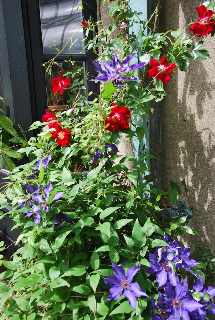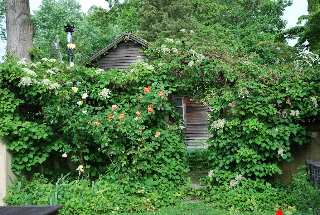
If a climbing red rose hadn't come with our house, I might not have fallen so hopelessly in love with climbers. The rose looked lonely as it climbed, the ivy as its trellis, on the side of our house. I tentatively added a few more to the house. Overtime, as I realized how little care climbers required and how much beauty they added, there was no stopping me. Now climbing roses lend their charm to doorways, arbors, porches, gazebos, fences, walls and trees. Over the last fifteen years I added four or five dozen more, of approximately two dozen different varieties. My favorites-- "Aloha," "American Pillar," "Cecile Brunner," 'Golden Showers," "New Dawn," and "Zephirine Drouhin"--repeat themselves around the yard.
The impact of climbers, whether short or tall, does more to beautify a garden with its finishing touch than anything else I can think of. Climbing roses, thankful for a place on a warm wall, smile down at me from the heights and it is impossible not to smile back. They are cordial characters, combining easily with each other, and bringing joy wherever they meander.
A garden appears larger when flowers bloom vertically. Climbers dress up any dull area--beautifying even from a distance. We all know roses are the world's most loved flowers. But the pleasure of sitting under a canopy of roses is enjoyed by relatively few. Their only draw back is their bare legs so I use the woody-stemmed canes of the roses as living supports for loose-limbed, delicate vines such as clematis, love-in-a puff, honeysuckle and sweet peas.
Climbing roses don't really climb; at least not the way vines do. Most climbing roses sprawl, arch, and creep up or scramble over the ground, stretching out their awkward canes. Some climbers grow 20 to 30 feet and beyond, while others only grow 8 to 12 feet. The first few years I rarely prune them until they cover the area I have allotted. If they grow out of reach, up a tree for instance, I wish them well and wait for the tree to be alive with flowers.
The shorter climbers should be pruned to force the main canes to grow up and out the sides, arching into a fan shape against the wall. With arched branches, more of the cane is exposed to the sun, encouraging more flowers to form at each node.
To be successful with climbers it is important to watch them in the spring during periods of quick growth to see what they want to do and then learn to work with them. As they grow loosely tie the canes to the structure they are to climb (a trellis, arbor, wires, etc.) using a soft or elastic material such as string, or strips of fabric. Any long limbs left flapping in the breeze can be easily damaged.
All climbers are like wayward children needing guidance. But often their wanton ways lead to unexpected beauty as when a climbing rose reached over my cement wall and down the other side giving a floundering clematis an arm to climb on.
My approach to planting climbers is the more the merrier. On an arbor leading to a small orchard I combined three repeat blooming roses and a clematis. It is a happy combination as each compliments the other. In early May, the cerise-pink flowers of "Zephirine Drouhin" open on almost thornless stems. A few weeks later, the velvety red large flowers of 'Don Juan' join the show and add their wonderful perfume.
By mid June Kathleen's almost-single, two-tone pink flowers steal the show with sheer number of blooms. For a time all three bloom together until the heat of summer when they need a rest. It is then that the small, double, dusky-violet flowers of Clematis viticella "Purpurea Plena Elegans" bloom. As fall approaches, the roses get a second wind and bloom is restored.

Since I don't deadhead the climbers, I am blessed with assorted decorative rose hips in a great variety of sizes, shapes and colors from the tiny red pearls on Rosa multiflora to the bright orange babbles on "Mme Gregoire Staechelin." Many of the hips stay through the winter providing nutritious food for the birds.
When next in your garden, look up. Isn't there something that could be enlivened by the colorful robes of a climber?
